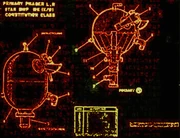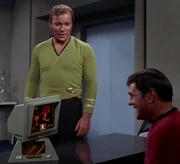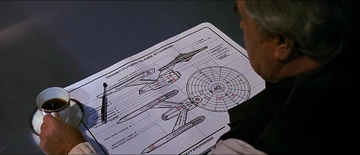The Starship-class was a spacecraft classification used by the United Federation of Planets Starfleet from its inception in the mid-22nd century to the late-23rd century. The exclusivity of the term "starship" as a class essentially fell out of use by the late 23rd century, and was redefined as a term interchangeable with spaceship and spacecraft. Starship-class vessels, like the Constitution-class and the Constitution II-class, were then referred to as heavy cruisers. (Star Trek: The Original Series; Star Trek III: The Search for Spock; Star Trek V: The Final Frontier; ENT: "In a Mirror, Darkly, Part II"; DIS: "Such Sweet Sorrow")
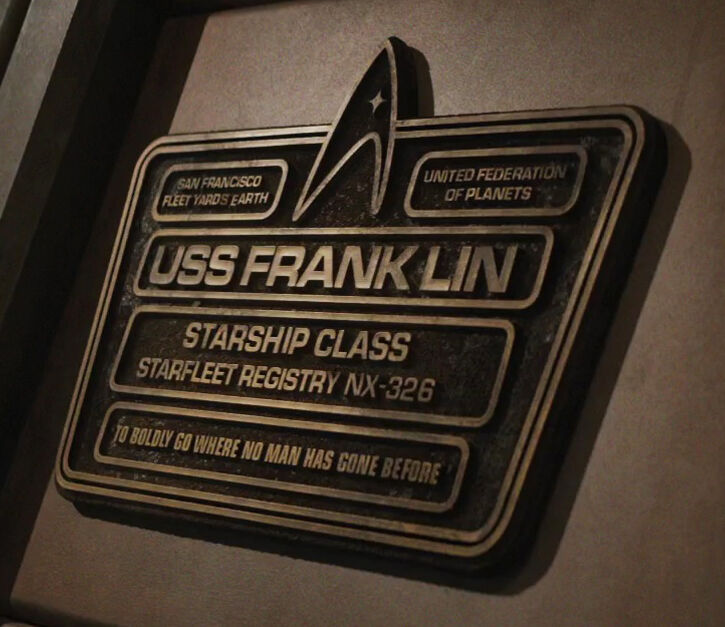
The Freedom-class USS Franklin was listed on its Federation dedication plaque as a Starship-class vessel when it was reported missing in 2164. (Star Trek Beyond)
Since the Franklin was stated to be Earth's first warp 4 ship, and Earth's first warp 5 ship, Enterprise NX-01, wasn't listed as a Starship-class vessel in the decades leading up to the formation of the Federation, it would seem that the former ship was reclassified as being in the Starship class after Enterprise was decommissioned, and the Federation formed, in 2161.
The mid-23rd century Constitution-class was listed as being in the Starship class on the dedication plaque of the USS Enterprise.
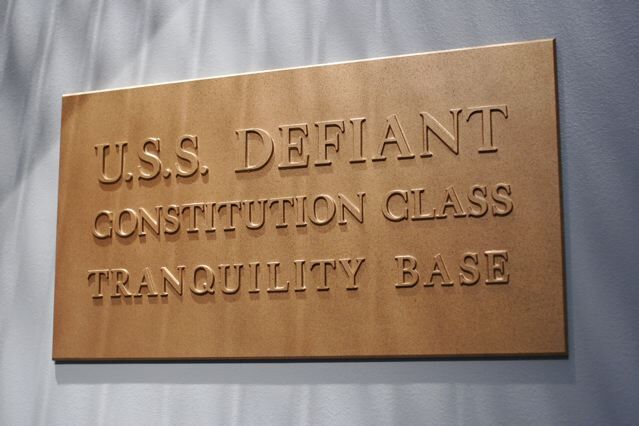
Constitution-class had replaced Starship-class on the dedication plaque of the USS Defiant in 2268. (ENT: "In a Mirror, Darkly, Part II")
The mirror universe version of the Constitution-class was also listed as being in the Starship class on that universe's ISS Enterprise's dedication plaque. (DIS: "Mirrors")
The alternate reality version of the Constitution-class was also listed as being in the Starship class on that reality's USS Enterprise's dedication plaque. (Star Trek; Star Trek Into Darkness; Star Trek Beyond)
| Starship types |
|---|
| attack vessel • attack fighter • battle cruiser • battleship • bird-of-prey • carrier vessel • colony ship • combat cruiser • corsair • corvette • cruiser • destroyer • diplomatic vessel • dreadnought • escort vessel • exploration vessel • flagship • freighter • frigate • garbage scow • geo-terraforming vessel • heavy cruiser • holding vessel • interceptor • light cruiser • medical ship • military vessel • mining vessel • patrol ship • pilot vessel • prison ship • raider • reconnaissance ship • robot ship • runabout • science vessel • scout ship • star cruiser • starliner • starship • supply ship • support ship • survey ship • tanker • timeship • trading vessel • training ship • transport ship • troop transport • tug • warbird • warship |
Appendices
Background information
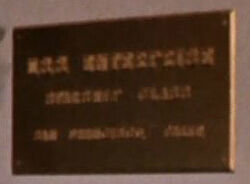
Production materials reproduced in Stephen Whitfield's The Making of Star Trek suggested that the term "Starship" was a unique designation for space-going vessels. In that vein, the USS Enterprise and her sister ships were originally designated "Starship-class" vessels. The dedication plaque on the bridge designates the ship as "USS Enterprise, Starship-Class".
Harcourt Mudd referred to the ship and others of its ilk with that same term in the final draft script of TOS: "Mudd's Women" (dated 26 May 1966), though the on-screen equivalent of the line changes it to Mudd merely calling the Enterprise and its counterparts "starships". The term "Constitution-class" originated from the script for the season one episode "Space Seed". Scenes 44 and 48 of the second revised final draft script for "Space Seed" (dated 13 December 1966) had the following content:
- 44 ANGLE ON SICK BAY VIEWER
- It is covered with mathematical symbols and diagrams. CAMERA PULLS BACK to show Khan studying with great concentration. He pushes a button. Another transparency appears: a chapter heading, reading: BASIC SPECIFICATIONS, CONSTITUTION CLASS STAR SHIP
and,
- 48 INSERT – SCREEN
- A chapter heading: Basic Propulsion Systems, Constitution Class Star Ship.
That the scripted screen indicators indeed pertained to Kirk's ship followed from the prior conversation:
- "I was once an engineer of sorts. I would be most interested in studying the tech manual on your vessel. After all, I have two hundred years of catching up to do."
- "They are available on your viewing screen there. Dr. McCoy will show you how to hook into our library tapes."
- - Khan and Kirk, in the sickbay of the Enterprise
The graphic that was constructed for this script direction, but which was ultimately not used in the episode according to the influential "The Case of Jonathan Doe Starship" article by Greg Jein, published in the April 1973 issue 27 of the T-Negative fanzine, did make its first canon appearance in the second season episode "The Trouble with Tribbles", as an otherwise unreadable graphic of a technical journal on a computer screen that Montgomery Scott was reading, showing a phaser bank diagram for a "Constitution-class" starship. The graphic was actually created by Art Director Matt Jefferies, who used his own extensive aviation library as his source. Depicted were two varieties of hydraulic fluid reservoirs, used by the US Air Force at the time. [1](X) The graphic was endowed with a caption, gleaned by Jein for his article after he had obtained a trimmed clipping from Lincoln Enterprises showing the graphic in its entirety, that read:
- PRIMARY PHASER L, R
- STAR SHIP MK IX/01
- CONSTITUTION CLASS
While this scripted reference was "understood" to have established the Enterprise belonging to the Constitution class ever since by production staffers and fans alike, it was not until 1982 that the designation started to seep into canon. Authors of reference works such as Franz Joseph's Star Fleet Technical Manual were privy to scripts' contents, and to the fact that Enterprise herself was Constitution class, even though it had never been mentioned in dialogue or been readable on screen. Drawings from the aforementioned Technical Manual with the class name appeared on screen, again unreadable, in Star Trek II: The Wrath of Khan and Star Trek III: The Search for Spock. These were the first occasions a canonical production assigned the Constitution name to the class designation of the Enterprise. Star Trek IV: The Voyage Home assigned this class name to the refit Enterprise as well, although some production staff previously and, apparently, unofficially called that design Enterprise-class, which actually was utilized, and discernible, for the Mark IV bridge simulator seen in The Wrath of Khan. The name Enterprise-class was also used in reference to the refitted Enterprise and the Enterprise-A in Mr. Scott's Guide to the Enterprise, though that particular reference book is neither considered canon nor "official". (Star Trek: The Magazine Volume 2, Issue 11, p. 71)
The first time it was actually referred to as such in dialogue, was by Captain Jean-Luc Picard in the first season episode "The Naked Now" of Star Trek: The Next Generation. Series scenic artist Mike Okuda gave the reasoning behind the at long last class confirmation in canon, "We went with "Constitution" on TNG because it satisfied fan expectations, and because it implied that there were many different types of starships, which in turn implied that Starfleet was a bigger, more interesting, more capable organization." [2] Its first-time onscreen oral reference was followed by the first firm visual, clearly legible, confirmation in the form of the heading of a blueprint Scott was examining in Star Trek VI: The Undiscovered Country (originally created by Okuda for inclusion in the Operation Retrieve briefing charts, but eventually not featured there [3]), firmly establishing the fact in canon and concurrently dispelling any Enterprise-class notion definitively, as this blueprint also clearly noted his ship as a Constitution-class vessel. The designation has been mentioned several times and been more prominently visible in later series and episodes referencing ships of the Original Series and movies design. In the Star Trek: Enterprise episode "In a Mirror, Darkly" the dedication plaque of the USS Defiant (NCC-1764) clearly stated that she belonged to the Constitution class (in the original third season episode "The Tholian Web", the plaque, which was of course Enterprise's, could not be seen due to deliberate camera angles). Not being one of the ships listed in the original final names list as reproduced in The Making of Star Trek (p. 165), used by the production team of the series, and although not being canon, this strongly suggested two things according to Greg Jein: firstly, Starfleet changed its nomenclature from Starship-class to Constitution-class during the run of the TOS era (nicely tying in with Scott keeping abreast by reading technical updates for the ship he is working on, and actually confirmed in canon with the introduction of the Defiant plaque in "In a Mirror, Darkly"), and secondly, the Defiant belonged to a later batch of Constitutions (supported by the fact she had the highest registry number of all the then visually established original configuration Constitutions). Commissioned somewhere during the TOS era, she therefore had an unfortunately short career, at least in Star Trek's prime universe, or as Jein had succinctly put it, "Tough break". [4]
The "Starship" term denoted a large, multi-purpose vessel capable of taking on a variety of tasks during an extended mission, often at some distance from central authority (The nearest 24th century equivalent designation would be that of Explorer). This helps explain Merrik's reference to a "very special type of vessel and crew" ("…Kirk commands, not just a spaceship, but a Starship"), as well as the numerous references to the extraordinary amount of authority granted to the captain of such a ship.
However, in Star Trek: The Motion Picture, as well as everything afterwards, the term fell into a more "generic" use, first as describing Federation vessels in general, and then large, faster-than-light-capable vessels from a range of cultures.
Likewise, the "NCC" registry was originally to be used only for the self-same Starship-class vessels, just like the modern CVN registry is used for nuclear-powered aircraft carriers of the United States (example; USS Enterprise CVN-65). That, too, as of TMP, had become "generic" among Starfleet ships. The NCC was inspired by the modern NC registry for non-commissioned (civilian) ships in the military. Since the Starship was an exploration vessel first and combat vessel secondary, Gene Roddenberry liked the parallel.
External link
- Starship class at Memory Beta, the wiki for licensed Star Trek works
